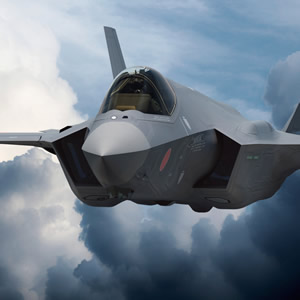The US Defense Security Cooperation Agency (DSCA) formally notified the United States Congress on 30 April of a potential Foreign Military Sale of Lockheed Martin F-35A Joint Strike Fighters (JSF) to Japan. The sale includes an initial order for four F-35A Conventional Take-Off and Landing (CTOL) stealth fighters with an option for the purchase of an additional 38 F-35A CTOL aircraft. The cost of the purchase is estimated to be $10 billion.
The announcement was published in a DSCA press release of 1 May. US law requires the Congress be notified of potential foreign sales and does not represent a completed contractual obligation.
Each aircraft carries an estimated cost of $238 to $240 million that includes support throughout the aircraft’s lifetime. The overall deal includes the aircraft itself, Pratt & Whitney F-135 engines (including five spare engines), electronic warfare systems, command and control computers, software development and integration, spare parts, training, logistical support, and US government and contractor technical support and services. Other equipment in the package includes intelligence capabilities, navigation systems, an autonomic global logistics support system, GPS systems, and a flight mission trainer.
Japan has wanted to add a stealth aircraft to its air fleet for a long time, but failed in its efforts to negotiate a deal to acquire the Lockheed Martin F-22 Raptor.
The F-35 Lightning II was selected by Japan in December of last year beating out competing aircraft that included the Boeing F/A-18 E/F Super Hornet and the Eurofighter Typhoon. The F-35 is intended to replace Japan’s aging fleet of McDonnell Douglas/Mitsubishi F-4EJ Kai Phantoms. The plan is to retire the Phantoms as the F-35s are placed into operation. Japan hopes to take delivery of the first four F-35As by 2017. Full-scale production is expected to begin no earlier than 2019 should no further delays be encountered.
The DSCA press release stated that execution of the sale could take as long as fifteen years, but some defense analysts project that deliveries might begin as early as 2016.
Repeated delays, cost increases, and technical difficulties have plagued the JSF program from its inception. The situation has created some fairly widespread discontent among promising customers. Norway, Canada, Australia, Italy, and the United States have either delayed their purchase plans or reduced the initial numbers of aircraft they expected to acquire.
Japanese Minister of Defense Naoki Tanaka previously announced that Japan might find it necessary to cancel its preliminary order should the JSF program suffer further delays or if the price tag increases to an unacceptable amount.
Lockheed Martin has indicated that the F-35A can be delivered at an average cost of approximately $75 million per aircraft once full-scale production begins. This cost estimate is linked to the assumption that the United States and the eight partner nations involved in the JSF program will order a minimum of 3,100 aircraft over the next twenty-five years. Should the numbers ordered drop below this minimum, costs can be expected to escalate.
The prime contractors will be Lockheed Martin and Pratt & Whitney Military Engines and no offset agreement is known to be tied to this sale. US government technicians and contractor representatives will need to have a continuing presence in Japan to conduct training, assembly activities, technical support, and program management for an estimated fifteen years.
Lockheed Martin’s Director of F-35 International Customer Engagement, Dave Scott, announced during the Singapore Airshow in February that Japan would be nominated as a final assembly and inspection site. With US government approval, this would allow the assembly of the four major aircraft components to be completed in Japan along with installation of electronics and the conduct of test flights.
As one of America’s most important and longstanding allies in the Asia-Pacific region, Japan’s self-defense capabilities are of extreme concern to the United States. Japan represents a key player in the maintenance of stability and peace in the region and is host to the largest US military presence in the Pacific.
This sale will go far in modernizing Japan’s aerial combat capabilities and will further strengthen US-Japan defense cooperation. Should all go well with this procurement, Japan might increase its F-35A order to between 100 and 120 aircraft allowing for the replacement of its existing force of Mitsubishi F-15 J/DJ fighters as well.

















